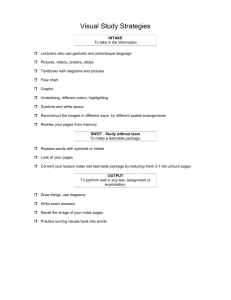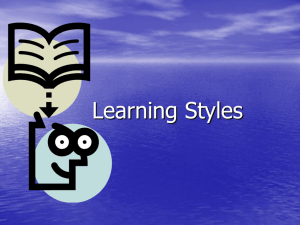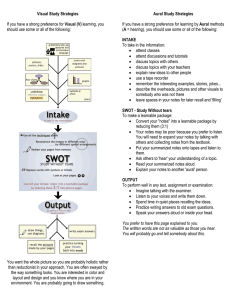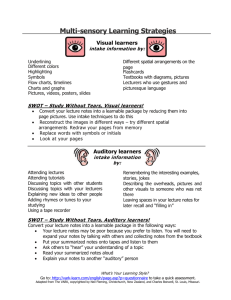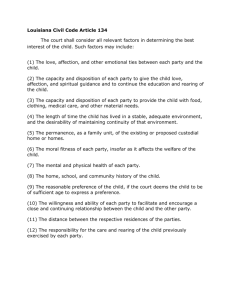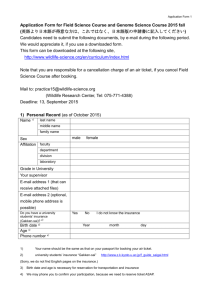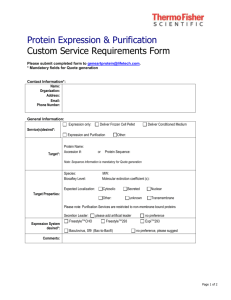Learning Style Strategies
advertisement
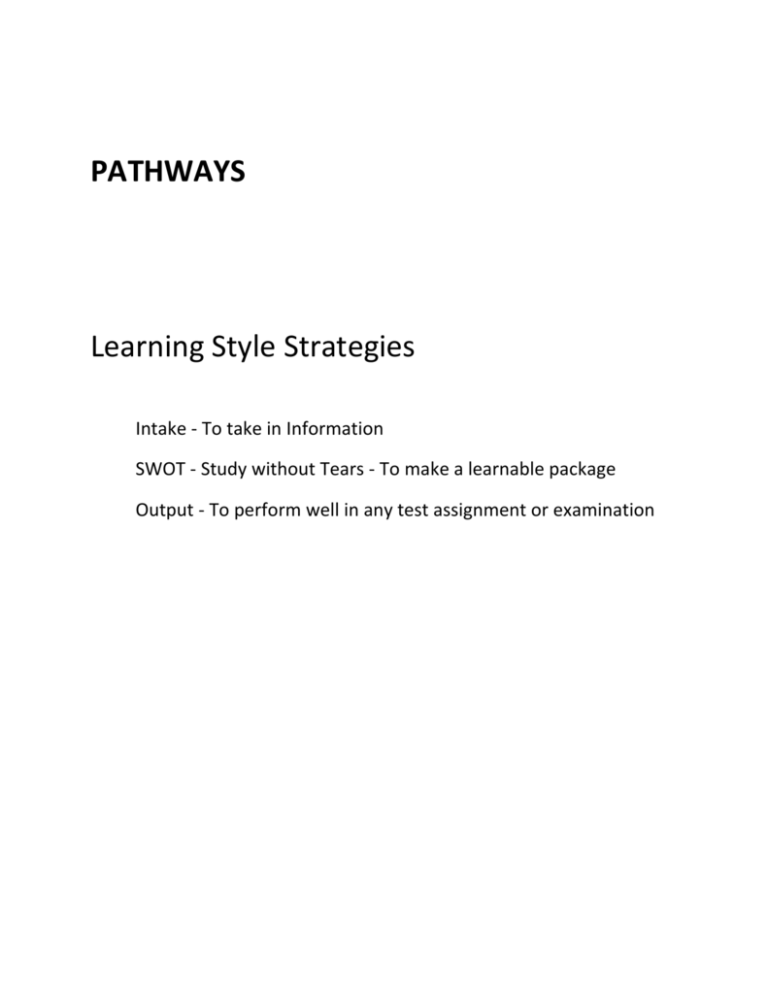
PATHWAYS Learning Style Strategies Intake - To take in Information SWOT - Study without Tears - To make a learnable package Output - To perform well in any test assignment or examination Visual Strategies Key words: different formats, space, graphs, charts, diagrams, maps and plans Description: This preference uses symbolism and different formats, fonts and colors to emphasize important points. It does not include video and pictures that show real images and it is not Visual merely because it is shown on a screen. If you have a strong Visual preference for learning you should use some or all of the following: INTAKE To take in the information: lecturers who use gestures and picturesque language pictures, videos, posters, slides flowcharts underlining, different colours, highlighters textbooks with diagrams and pictures graphs symbols @ and white space SWOT – Study without tears To make a learnable package: Convert your “notes” into a learnable package by reducing them (3:1) Use all of the techniques above Reconstruct the images in different ways… try different spatial arrangements. Redraw your pages from memory Replace words with symbols or initials Look at your pages. OUTPUT To perform well in any test, assignment or examination: Draw things, use diagrams Write exam answers Recall the pictures made by your pages Practice turning your visuals back into words You want the whole picture so you are probably holistic rather than reductionist in your approach. You are often swayed by the look of an object. You are interested in color and layout and design and you know where you are. You are probably going to draw something. Aural Strategies Key words: listening, discussing, talking, questioning, recalling Description: This preference is for information that is spoken or heard and the use of questioning is an important part of a learning strategy for those with this preference. If you have a strong preference for learning by Aural methods (A = hearing) you should use some or all of the following: INTAKE - To take in the information: attend classes attend discussions and tutorials discuss topics with others discuss topics with your teachers explain new ideas to other people use a tape recorder remember the interesting examples, stories, jokes… describe the overheads, pictures and other visuals to somebody who was not there leave spaces in your notes for later recall and ‘filling’ SWOT – Study without tears - To make a learnable package: Convert your “notes” into a learnable package by reducing them (3:1) Your notes may be poor because you prefer to listen. You will need to expand your notes by talking with others and collecting notes from the textbook. Put your summarised notes onto tapes and listen to them. Ask others to ‘hear’ your understanding of a topic. Read your summarised notes aloud. Explain your notes to another ‘aural’ person. OUTPUT - To perform well in any test, assignment or examination: Imagine talking with the examiner. Listen to your voices and write them down. Spend time in quiet places recalling the ideas. Practice writing answers to old exam questions. Speak your answers aloud or inside your head. You prefer to have this page explained to you. The written words are not as valuable as those you hear. You will probably go and tell somebody about this. Read/Write Strategies Key words: lists, notes and text in all its formats and whether in print or online. Description: This preference uses the printed word as the most important way to convey and receive information.If you have a strong preference for learning by Reading and Writing (R & W) learning you should use some or all of the following: INTAKE - To take in the information: lists headings dictionaries glossaries definitions handouts textbooks readings – library notes (often verbatim) teachers who use words well and have lots of information in sentences and notes essays manuals (computing and laboratory) SWOT – Study without tears - To make a learnable package: Convert your “notes” into a learnable package by reducing them (3:1) Write out the words again and again. Read your notes (silently) again and again. Rewrite the ideas and principles into other words. Organize any diagrams, graphs … into statements, e.g. “The trend is…” Turn reactions, actions, diagrams, charts and flows into words. Imagine your lists arranged in multiple choice questions and distinguish each from each. OUTPUT - To perform well in any test, assignment or examination: Write exam answers. Practice with multiple choice questions. Write paragraphs, beginnings and endings. Write your lists (a,b,c,d,1,2,3,4). Arrange your words into hierarchies and points. You like this page because the emphasis is on words and lists. You believe the meanings are within the words, so any talk is OK but this handout is better. You are heading for the library. Kinesthetic Strategies Key words: senses, practical exercises, examples, cases, trial and error. Description: This preference uses your experiences and the things that are real even when they are shown in pictures and on screens. If you have a strong Kinesthetic preference for learning you should use some or all of the following: INTAKE - To take in the information: all your senses – sight, touch, taste, smell, hearing … laboratories field trips field tours examples of principles lecturers who give real-life examples applications hands-on approaches (computing) trial and error collections of rock types, plants, shells, grasses… exhibits, samples, photographs… recipes – solutions to problems, previous exam papers SWOT – Study without tears - To make a learnable package: Convert your “notes” into a learnable package by reducing them (3:1) Your lecture notes may be poor because the topics were not ‘concrete’ or ‘relevant’. You will remember the “real” things that happened. Put plenty of examples into your summary. Use case studies and applications to help with principles and abstract concepts. Talk about your notes with another “K” person. Use pictures and photographs that illustrate an idea. Go back to the laboratory or your lab manual. Recall the experiments, field trip… OUTPUT - To perform well in any test, assignment or examination: Write practice answers, paragraphs… Role play the exam situation in your own room. You want to experience the exam so that you can understand it. The ideas on this page are only valuable if they sound practical, real, and relevant to you. You need to do things to understand. Multimodal Strategies These are the various combinations of the four preferences below. If your VARK Profile is for Visual and Kinesthetic (VK) you will need to use those two descriptions and key words in the strategies below. Visual Strategies Aural Strategies Read/Write Strategies Kinesthetic Strategies Keep in mind that some people with a multimodal preference need to have the same material presented in several of their modes in order to really learn it, while others can effectively learn using any single one of their multiple preferences.
